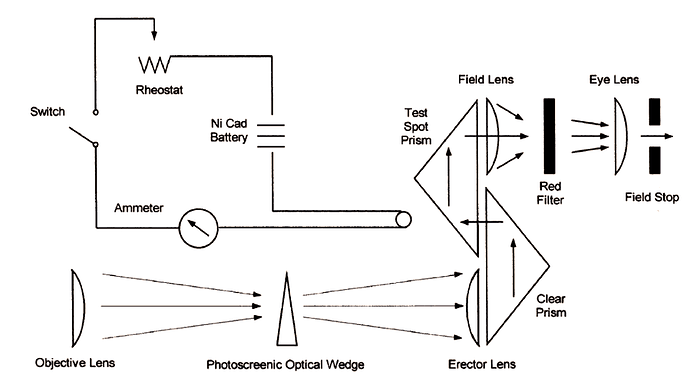Unlike the thermometer, RTD and the thermocouple, pyrometers (non-contact temperature sensors) measures the amount of heat radiated, rather than the amount of heat conducted and convected to the sensor.
Various types of pyrometers, such as total radiation and photoelectric pyrometers, exist. Below is a schematic of an optical pyrometer in Figure 4.
Pyrometers
Figure 4. Schematic diagram of an optical pyrometer
These pyrometers differ in the type of radiation they measure. There are many factors that influence the amount of radiated heat detected, thus there are many assumptions that must be made regarding the emissivity, or the measure of the manner in which heat is radiated, of the object.
These assumptions are based upon the manner in which heat is radiated as well as the geometry of the object.
Because temperature is dependent on the emissivity of a body, these assumptions regarding the emissivity introduce uncertainties and inaccuracies in the temperature readings.
Therefore, because of the error associated with them, pyrometers are not often used in industry.
There are a few different types of pyrometers.
There are
- optical and
- radiation pyrometers.
How Optical Pyrometers Work:
- Compares the color of visible light given off by the object with that of a electrically heated wire
- The wire can be preset to a certain temperature
- The wire can be manually adjusted to compare the two objects
How Radiation Pyrometers Work:
- This sensor works by measuring the radiation (infrared or visible light) that an object gives off
- The radiation heats a thermocouple in the pyrometer which in turn induces a current
- The larger the current induced, the higher the temperature is.
Pyrometers are usually used at very high temperatures, but can be used at colder temperatures as well. There are lots of industrial applications to pyrometers. Plant operators can use pyrometers to get a sense of what temperature certain processes are running at. The downside to pyrometers is that they are not very accurate as thermocouples or RTD sensors are. This is because they rely on quantifying colors of light.
